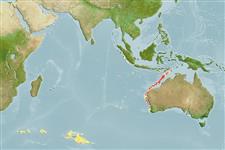>
Perciformes/Cottoidei (Sculpins) >
Psychrolutidae (Fatheads)
Etymology: Psychrolutes: Greek, psychroloutes = someone that has a cold bath (Ref. 45335); occidentalis: Specific name refers to its distribution in Western Australia.
More on author: Fricke.
Environment: milieu / climate zone / depth range / distribution range
Ökologie
seewasser bathydemersal; tiefenbereich 350 - 704 m (Ref. 28169). Deep-water
Eastern Indian Ocean: known only around Rowley Shoals, Western Australia.
Size / Gewicht / Alter
Maturity: Lm ? range ? - ? cm
Max length : 11.1 cm SL Männchen/unbestimmt; (Ref. 28169); 11.5 cm SL (female)
Found on the continental slope. Benthic (Ref. 75154).
Life cycle and mating behavior
Geschlechtsreife | Fortpflanzung | Ablaichen | Eier | Fecundity | Larven
Fricke, R., 1990. A new species of psychrolutid fish from Western Australia. Jap. J. Ichthyol. 36(4):404-409. (Ref. 28169)
IUCN Rote Liste Status (Ref. 130435: Version 2024-2)
Bedrohung für Menschen
Harmless
Nutzung durch Menschen
Tools
Zusatzinformationen
Download XML
Internet Quellen
Estimates based on models
Preferred temperature (Ref.
123201): 7.9 - 10.6, mean 8.3 °C (based on 10 cells).
Phylogenetic diversity index (Ref.
82804): PD
50 = 0.5005 [Uniqueness, from 0.5 = low to 2.0 = high].
Bayesian length-weight: a=0.01000 (0.00244 - 0.04107), b=3.04 (2.81 - 3.27), in cm total length, based on all LWR estimates for this body shape (Ref.
93245).
Trophic level (Ref.
69278): 3.3 ±0.5 se; based on size and trophs of closest relatives
Fishing Vulnerability (Ref.
59153): Low vulnerability (10 of 100).
